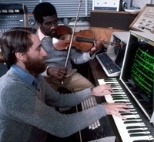On Friday, May 21 at 8pm, the Media Laboratory will host "Digital Rewind," a concert featuring important works of experimental computer music, in commemoration of the founding of MIT's Experimental Music Studio (EMS) 25 years ago.
The free concert in Kresge Auditorium will conclude an international symposium honoring the contributions of the composers and music researchers associated with the EMS. The evening's performances will include two world premiere pieces: a reworking of At Last...Free for Max Mathews' Radio Baton by Richard Boulanger and an interactive rendition of Synapse for viola and computer by Professor Barry Vercoe. For more information, call x3-2727.
Known as one of the most innovative research facilities in the field of experimental music, the EMS contributed several seminal compositions to the genre of computer music, some of which will be performed at the May 21 event. The concert will include works by internationally recognized composers who worked at the EMS: William Albright, Richard Boulanger, Professor Peter Child, James Dashow, Mario Davidovsky, Associate Professor Tod Machover, Jean Claude Risset and Professor Vercoe.
The performance will also feature some of the most celebrated musicians in experimental music, including members of the Boston-based Collage New Music, Professor Marcus Thompson (viola), David Horne (piano) and Curtis Macomber (violin). Examples of the technology developed at the EMS and the Media Lab will be on exhibit in Kresge's lobby before the performance. Doors to the exhibit will open at 7pm.
WORLD PREMIERES
Both premieres on the concert program feature innovations in music technology. Professor Vercoe's work Synapse, composed in 1976 for violist Marcus Thompson, treated both musician and computer-synthesized accompaniment as equally salient musical entities.
When the piece was written, technological limitations placed the burden of synchronization during performance on the musician. Now, modern digital processing techniques offer more creative possibilities and have enabled composers to incorporate real-time synchronization and genuine computer interaction into their compositions. In early 1999, Professor Vercoe revisited Synapse to explore the interactive potential of this important work.
"When you have a technology that enables composers and performers to do new and different things, that will always excite the imagination," said Professor Vercoe, likening modern advances in signal processing to the development of musical instruments with responsive control such as valved trumpets.
Professor Vercoe noted that while his compositions use the latest technologies, they are human-driven. "I've always been in love with the live aspects of music and see them as an extension of natural body motion," he said. "There's a contribution that humans do make, either through vocal chords or tactile control or whatever, that is an essential human communication."
Richard Boulanger's At Last... Free features Max Mathews's "radio baton," a device that tracks the motions of two conducting batons in three-dimensional space. The position and movement of the batons are converted into MIDI (musical instrument digital interface) data, which are sent to a computer that modifies a score in real time with the conductor's movements. In honor of the EMS's 25th anniversary celebration, MIT commissioned Dr. Boulanger to rework this exceptional composition.
THE EMS
Founded by Professor Vercoe at MIT in 1973, the EMS was the first facility to have digital computers dedicated to full-time research and composition of computer music. Committed to moving technology forward in artistic ways, the EMS hosted the first International Conference on Computer Music in 1976.
During its first 12 years, the EMS was responsible for developing or advancing computer-based music technology such as real-time digital synthesis, live keyboard input, graphical score editing, synchronization between natural and synthetic sound in composition and advanced computer languages for music composition. The prevailing musical aesthetic at the EMS encouraged explorations into the interaction between live performers and computer accompanists.
In 1985, Professor Vercoe became one of the founding faculty members of the Media Lab, where he has directed research groups on music and cognition, synthetic listeners and performers, and machine listening. His own research interests span music theory, signal processing, music perception and audio coding. He is the inventor of several computer languages for digital music synthesis that have been used by thousands of composers around the world.
A version of this article appeared in the May 19, 1999 issue of MIT Tech Talk (Volume 43, Number 31).






